Director and Screenwriter: Michael Powell and Emeric Pressburger
Starring: Anton Walbrook, Marius Goring, and Moira Shearer
Images from the 1999 Criterion Collection release.
There are two fundamental kinds of self-reflexive films. Those that reflect the medium explicitly, such as The Player or Sunset Blvd., and those that convey an interior, implicit reality, such as Michael Powell and Emeric Pressburger’s The Red Shoes (along with Rear Window and The Double Life of Veronique). There is, of course, plenty of overlap, and I simply cannot make a value judgement on which is more important. It could be said that the latter is simply a broader realization of the former, but I like to think of them as two separate perspectives: one of an interior relatability and another of external realities. Both complement one another like the body and the soul.
There are two fundamental kinds of self-reflexive films. Those that reflect the medium explicitly, such as The Player or Sunset Blvd., and those that convey an interior, implicit reality, such as Michael Powell and Emeric Pressburger’s The Red Shoes (along with Rear Window and The Double Life of Veronique). There is, of course, plenty of overlap, and I simply cannot make a value judgement on which is more important. It could be said that the latter is simply a broader realization of the former, but I like to think of them as two separate perspectives: one of an interior relatability and another of external realities. Both complement one another like the body and the soul.
The musical is one of my favorite genres, and while The Red Shoes is no musical, it is, I believe, reflective of the melodrama that the genre often achieves. Both are not representations of reality so much as expressions of emotion. Expressionism is usually appended to German works conveying an emotional reality, and while classic film examples are Pandora’s Box or Metropolis, I believe expressionism is applicable to musicals and films of that ilk as well.
There is something hyper-real about the luscious Technicolor of The Red Shoes, and the film pulses as if blood flows through its veins. It is difficult to describe and impossible to convey with a screenshot, but even in relatively still scenes, there seems to be motion in the colors, as if they are beating to some silent rhythm. Every time I see the Technicolor in these sorts of films, an entirely closed system is opened up to me. These films almost don’t seem like a photographed external reality, but rather an interior reality, almost like a cartoon.
The division between reality and fantasy plays out over and over again in movies, since it is something inherent to film and audience, literature and reader, or listener and music. What these texts do is pull someone into an alternate reality and transmogrify their experience through vicariousness. How many times have you think you’ve experienced something, but then realize it was something you saw in a movie or read in a book? Yet, it is reductionist to simply point at fiction as merely shadows on a screen or words on a page with no sway towards actual experiences.
There is something about picking a film apart, like how one takes apart a machine to see how it works, that reduces the magic created by it. It’s as if the images on screen serve the same purpose as words in a story: as a guide that inspires imagination within the viewer. Perhaps, then, the magic lies not in the medium alone but the interplay between a viewer’s mind and the medium.
If it sounds like I’ve digressed, it’s because I have, to an extent. The Red Shoes is less concerned with the audience and more with the creators of what the audience takes in. Martin Scorsese loves the film, and the fight scenes in Raging Bull are inspired by the subjective reality of “The Red Shoes” ballet, which emphasizes the writers, directors, producers, and dancers while distancing itself from the audience. Notice the emphasis of the screenshots sandwiching this paragraph on Julian, Vicky and Lermontov. The audience becomes a background, like the ambience of waves crashing against rocks. Yet, it is the same ability to crawl inside a medium that binds the audience to performer, and since I have never had a hand in creating art and am not professionally engaged to film/art, I must find another way to relate to what goes on within the movie screen to my own experience.
What The Red Shoes does so brilliantly is juxtapose images that suggest a fusion between fantasy and reality. Perhaps this goes back to the look and feel of the film, in that it is simultaneously filmed reality (people before a camera) and a representative of an expression and mood (conveyed by the sumptuous colors and the dramatic arc). Nowhere do these images merge more beautifully than in “The Red Shoes” ballet. Like many musicals, the film gives us an extended sequence that is entirely self-contained and stands alone as a masterpiece unto itself, like a story within a story. Yet the best of these pieces, like “Broadway Melody” in Singin’ in the Rain, “Let’s Face the Music and Dance” in Follow the Fleet, and “The Red Shoes” ballet are simultaneously standalones as well as serving to enhance the film they’re in, commenting on the thematic elements and expressing them in a highly cinematic mode of storytelling.
Another short digression, but generally speaking, the two least interesting aspects of films, for me, tend to be the story and dialogue. Invariably, when I’m asked about a movie, it’s about “the story,” as if plot alone is enough to recommend it. For me at least, plot is the clothesline, but it is certainly not the clothing. It helps stitch the fabric of a film together, merging the pieces without overpowering these elements, which include character, mood, atmosphere, and symbolism. The unimportance of the story in my mind, explains why I consider The Red Shoes to be as much about film as it is about dance, even if there is nary a mention of movies throughout the picture.
All of this, I think, is contained within “The Red Shoes” ballet, which sort of magnifies the entirety of the film within its 20 or so minutes. It is like watching the film in miniature, and in the process, it explores the medium of cinema itself and compares it with the stage. The ballet, perhaps endlessly analyzable, begins from a viewer’s perspective and then crosses over into increasingly subjective angles, finally departing completely from the stage, only to reappear in the theater as the number closes. This is what I’ve come to recognize as fantasy surrounded by reality and is representative of the film going experience: as a film begins, we begin to lose reality and by the end, we slip away from fantasy, reciprocating the initial transition. Of course, this is more broadly applicable to fiction in general, although it is more filmic in the sense that the stage cannot shift perspective as easily.
Where it gets (even more) interesting is in viewing Vicky Page as an allegory for the acting piece of the filmic jigsaw puzzle. There is another moment where, in a flash of light, her dancing partner transforms into Lermontov. In another flash, Lermontov changes into Julian Craster. And there is another moment when Julian steps up on stage towards Vicky, but then transforms into a dancer. The film is transposing the conductor into the characters themselves, as if he is conjuring the characters into being with his baton, like a wizard wielding a wand. In a way, the film is arguing for the auteur theory in collaborative art forms like film or the stage. The conductor, like the director, is almost a puppet master pulling the strings and controlling the movements of the player (the puppet, incidentally, is used in The Double Life of Veronique, one of my very, very favorite movies).
Personally, I’m not crazy about the auteur theory, although I tend to identify movies by director, since they are generally the biggest creative force. While it is important to acknowledge every person involved in the filmmaking process, I also believe the film itself is like a living entity, acting and reacting to what it sees. There are some things that simply cannot be accounted for, and perhaps luck, fate, or whatever you want to call it is responsible. It is an invisible force, like strings being pulled by a higher power, or perhaps no power at all other than life itself. We are all governed by something which we cannot fully explain, and it is this mystery that causes Vicky to jump from the building. Yes, we can say she jumped because she couldn't take it anymore, but why was she so torn and what caused this?
The division between Vicky’s love for dance and her love for Julian is balanced on a razor, and upholding both, as the film implies, is difficult. Her obsession with either one is like a love affair, and there is an interesting shot of her dresser where we see a picture frame. One half has a photograph of Julian, and the other is a cartoon of what appears to be Lermontov. When Julian storms in her dressing room, it is like the husband catching the adulterous wife. Interesting, too, that Lermontov’s picture is a drawing, perhaps reminding us that dancing is an alternate reality from “real life.”
Boris Lermontov is a caricature more than a complete human, representative of having complete devotion to a craft and treating it like a religion. There is a shot that, for me, more or less defines him: He is next to a statue of a ballerina’s shoe, literally placing it on a pedestal. His relationship with Vicky is intended to be completely professional, and I sense no lust in his obessesion with her.
The red shoes are an allegory of this life force tugging at an individual to make divisive choices. It is often said the shoes are representative of obsession with perfecting a craft. Just as Vicky puts herself inside them, she is immersing herself within the dancing profession, and this is applicable to virtually anything in life. The ending of the movie can be seen as the tug between love and vocation, finally tearing the individual apart.
I see the ending not so much as a tragedy, but as an allegory for transcendence. When Vicky dies, her spirit doesn’t float into the ether but rather becomes the red shoes. The ballet continues eerily without her, having the spotlight shine wherever she would be. This idea of having the performance transcend the body is, for me, a self-reflexive gesture that was foreshadowed in the earlier rendition of the ballet. The first time, the demonic shoemaker holds the red shoes and makes them dance, just like a puppet master (he can be seen as representative of Julian/Lermontov, who are in turn, representative of the filmmakers).
The film medium is incorporeal, yet the images on screen have a life of their own. Moira Shearer may have passed away, but she lives on in The Red Shoes, just like any other film actor's work. Having the final ballet with a physically incorporeal, yet imaginary and mentally tangible, dancer is indicative of the film medium itself. The demonic shoemaker is emblematic of the director, and there is a simultaneously intimate, yet violent, sequence where Vicky battles with the demon. It’s almost a love-hate relationship, in which there is a love between actor and director, and at the same time, hostility.
The Red Shoes is a magnificent, engrossing film. Like all movies, there needs to be some sympathy with what the film is trying to do, since it is melodramatic. It is a lyrical meditation on life and vocation, and attempting to balance on a tightwire above the two. Like The Double Life of Veronique, there is the sense of a metaphysical, transcendent state, in which artist and medium, audience and text, illusion and reality, merge into a single disposition. It is an act of love.

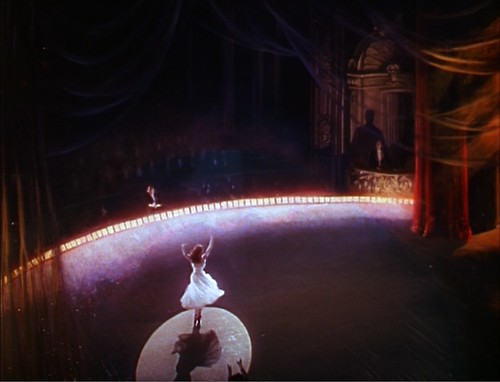
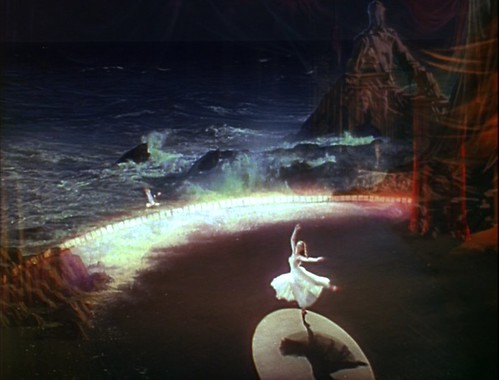
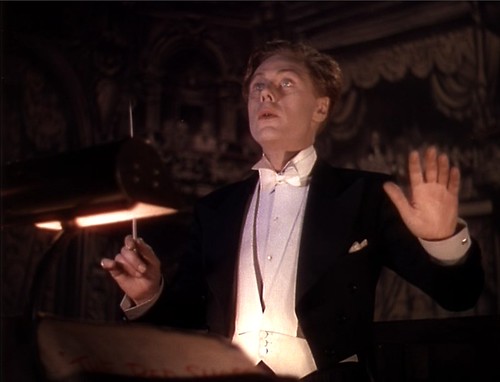
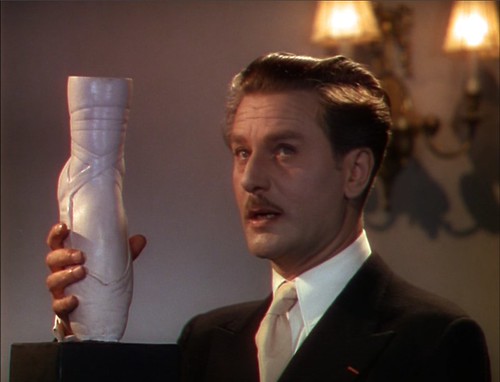
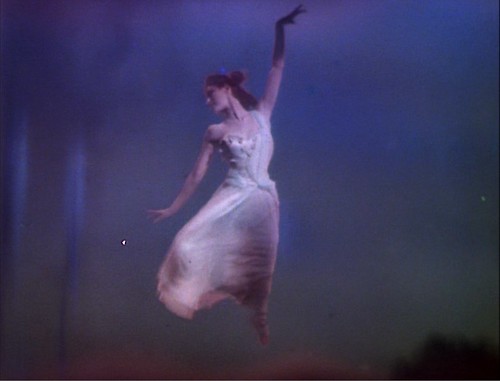
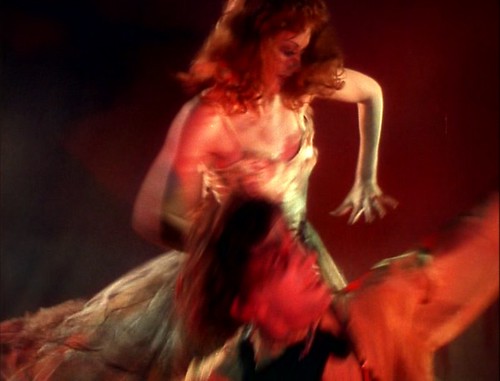
This post contains some brilliant reflections on the interaction of life, art, film, and the film-watching experience in its intensive analysis of a great movie. Like you, I'm not a complete fan of the auteur theory, but I do tend to identify a movie with its director, and for me Michael Powell is one of the greatest ever. And "The Red Shoes" is probably his best, most fully realized film (although my personal favorite is the decidedly atypical "I Know Where I'm Going"). This is simply a mind-blowing movie, and you specifically identified the things that make it so--and then some! All in all, a memorable post on a masterpiece of the cinema.
ReplyDeleteThat's a brilliant review on a brilliant movie! I was writing my own when I've come across that one.
ReplyDeleteAlthough I have somewhat different opinion about Lermontov and Vicky and lust :-) I must say your analysis is splendid.
What I like most about your review is that you take characters as they are - just characters. It's really difficult for me - partly because of my personal qualities and partly because I'm an actress and from Russia at that. And for me characters and most of all Lermontov looks a lot like real people. I'm sure I saw some in real life :-)Theatre people take their work as a vocation and tend to be so fanatic about it there. It's part of the national character maybe - if you do some kind of art, put you life in it and make everything else just an appendix to that... That's sad at times. So I was especially sorry for Lermontov in the end. Vicky's death could break him. Because when something is so strained it becomes very easy to break.
Well, it's to long a comment. I'm sorry. It just proves that The red shoes is an incredible work of art because it contains so much for every person who saw it.
Best wishes,
Galina Green
she looks very amazing as she dance on the photo.
ReplyDeletedickies scrubs